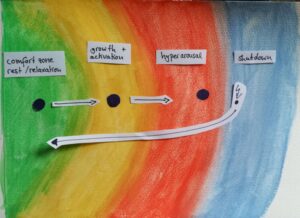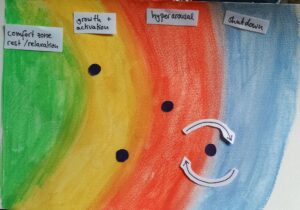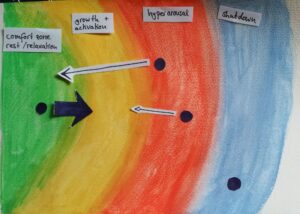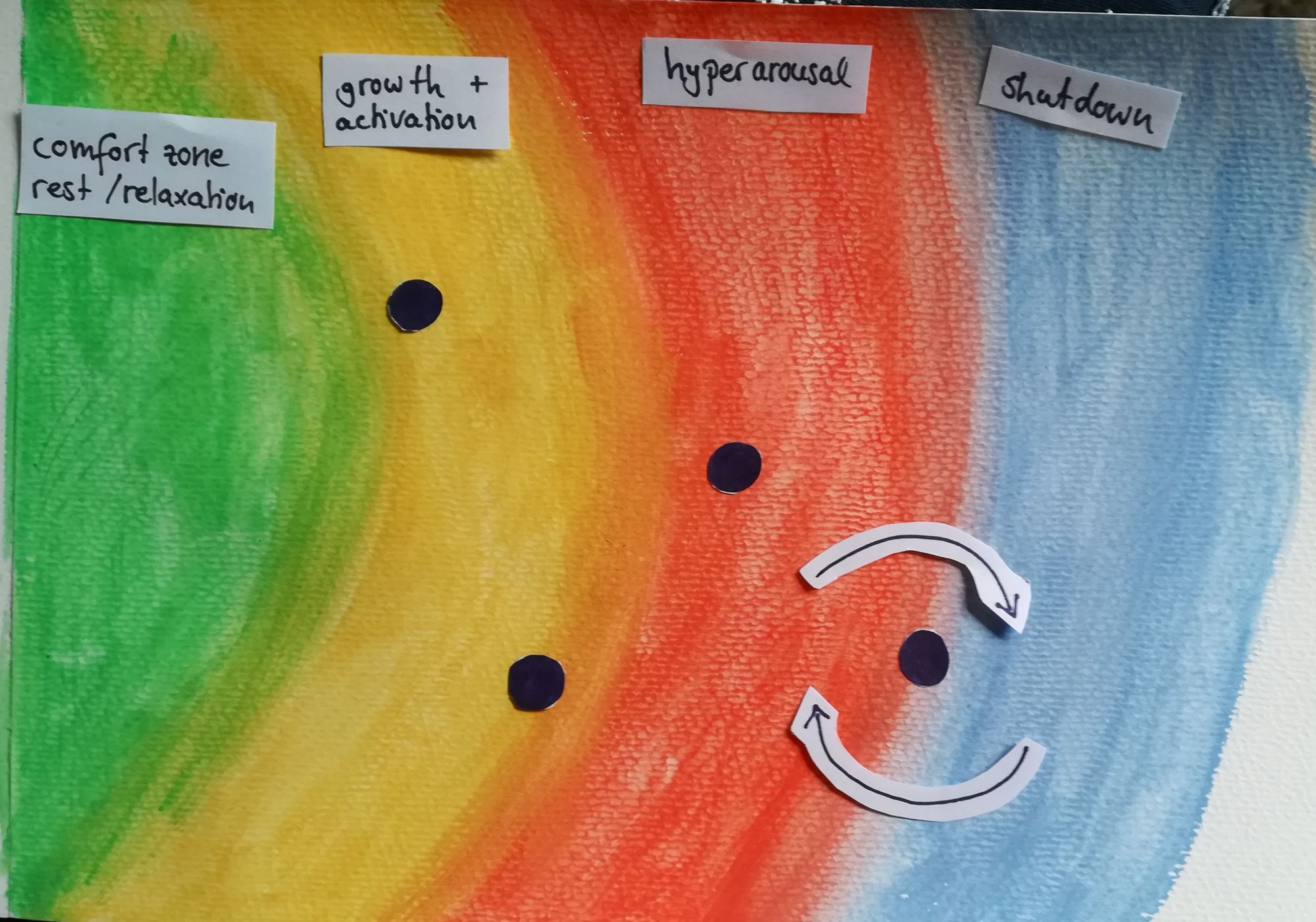Once we are aware that we go through different stress responses and that parts feel most comfortable in states that match their action systems we can use that knowledge to examine inner dynamics that cause us trouble. We might be drifting apart in response to the external situation we are in. The result is a power struggle or tug of war between parts that creates more distance between us.
Healthy people like to spend time in their comfort zone or in the zone of comfortable activation that we mark in yellow. It is where rest and growth happens. They feel overwhelmed when they go into Hyperarousal or Shutdown, the red and blue areas we are more familiar with. They usually experience a pattern where they get stressed and then they return to their comfort zone for recuperation. That creates a normal cycle of comfort and rest, challenge and growth, sometimes getting overwhelmed and then having a period of hiding from everything that is stressful to recover.

normal stress cycle
Exercise:
You can use a sand tray or simply a piece of paper and mark out the different stress zones. Try to figure out the states that each part feels most familiar or comfortable in and place their item in that area or put a symbol for them on your map. There really is no shame in liking high stress situations where coping gets wonky. That is a normal response to chronic stress and we might even enter states of high performance within these zones. Honestly admitting that this is the case can be a game changer for the system.

We experience the same zones healthier people have but they might feel different to us and we might not be able to finish the cycle into recovery properly. First of all we need to be aware that not every part feels comfortable within the rest & relaxation zone. Being there can feel dangerous and overwhelming. That is why some parts will sabotage our free time and get us into tricky situations. When hyperarousal feels most comfortable for a part because they are a protector and hypervigilance is how they function, they will try to stay within that zone. And parts who are most familiar with shutdown will move there to get a break and we don’t end up in recuperation and recovery at all. Instead of moving from overwhelm to rest we keep moving back and forth between hyperarousal and shutdown (More). This is a classic pattern we need to watch out for. It will take some extra effort to actually recover from stress.
When we feel our system drifting apart, moving into different directions or when we notice sabotage, power struggles or an unusual increase of amnesia, we can examine the current situation by asking every part which zone they are currently in. We visualize that as we have practiced with our general chart. Then we ask the parts how they feel being there and where they would like to go. Do they feel comfortable in their zone or do they want to change zones? And which direction do they want to move? Does it need more or less activation for them to feel better? We can mark these wishes using arrows. The thickness of an arrow can represent how badly a part wants to move in a certain direction.

When we look at the orientation of the arrows we get a better idea of what is happening. Some parts will probably try to move in opposite directions. Part A needs a break but part B experiences rest as an unbearable sensation that has to be avoided at all cost and things have been too quiet for them already. Maybe part C wants rest too but all they ever get is the switch between hyperarousal and shutdown. Someone wants to continue resolving a challenge at work while someone else feels overwhelmed already. Maybe Shutdown feels safe and every other state seems to be too much to handle. Whenever we have big arrows going in opposite directions, we need to pay attention to our next steps. The opposing tendencies create a tug of war. Some push, others pull, and the more pushing there is the more pulling is needed and the result is usually chaos of some kind. Blackouts with self-harm, amnesia for having done some kind of sabotage to your plans, panic, fatigue and burnout, or just a constant internal struggle that ends in Shutdown are signs of this dynamic.
Understanding the needs of different parts within a situation helps us to sort through the inner conflict. We don’t have to go into a power struggle of who gets to make the decisions in the situation when we realize that there is more than one experience concerning that situation and some parts are just in a bad place. It opens up the inner work to addressing the needs and the regulation issues instead of arguing about pro and contra lists of external facts. Sometimes those lists are great but they do not resolve conflicting needs.
Next, we ask our parts what they need to get to the place they want to be in, and whom they need it from. Sometimes there are things they can do themselves, they already know the resources that would help them to feel better or they know something someone else could do for them. It can be as simple as getting a plushie for them to see and touch while we take care of the outside situation. When we work with younger parts who have less experience with help, we can offer different options to choose from and give them time to test them out. It’s not always necessary to leave a situation altogether or drop everything we are doing. Compromises in the way we are doing them can go a long way. Sometimes we are just doing them too fast. With other parts being closer to where they feel comfortable we won’t experience as much conflict and tugging and we might be able to manage the situation well.
Summary of the questions you can ask:
In which zone are you right now?
How do you feel about being there?
Where do you want to go? (You can also just stay)
What do you need to get there?
Whom do you need that from?
Reverse consent
In some cases we get stuck. Needs are opposing each other in such a way that no compromise can be found. Simply voting would be devastating because a majority of parts would subdue other parts who are already hurting. If that happens a couple of times with the same parts having to submit and suffer, we set the scene for war. When it comes to needs, democracy is rarely a good thing within a system. It only ever makes the stronger group of parts win.
In these cases, we can list all the possible options and ask each part to rate how bad they think each option is. Instead of a vote we create a chart that tells us which options are the worst for everyone and which one sucks the least, even if its not good. Having a chart like that can help everyone to see that maybe their personal wish sucks for most parts and it might not be so cool to demand that. It can also help parts to see that there is no good solution and agreeing to one they dislike is still going to cause the least harm to the system. Hopefully everyone can consent to doing the thing that is the least awful for the team. This kind of reverse process is only needed when you get this extreme pattern of parts drifting into opposing directions. Don’t give up your regular votes. Those are still a fast and easy tool for simple situations.
Eventually we will reach a place where we go through normal stress cycles and we will feel the need for rest and recovery after stressful moments. It can be so foreign that it feels like something is wrong but we are actually just returning to healthy functioning. We will need a lot more rest than we expected. As we keep reducing overwhelming stress we will slow down the cycles and the situation will normalize.
You can take the whole idea of standing in different zones and remove it from stress states and instead use something like roles to see who feels comfortable where. The action systems parts operate in cover roles as much as stress states and it could be useful for Teaming to see if someone might feel bad in the role they have to fulfill in a situation and how responsibilities could be shifted. The questions will stay the same, only the context changes.
This is not a classic DID therapy tool. I adapted it from a model about group dynamics because I thought it was useful.

